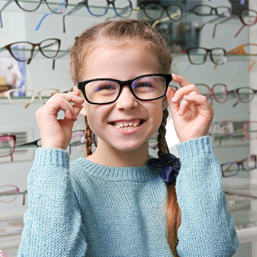
It’s something Calgary Optometrist, Dr. Tamara Maillot Delong, will never forget.
“He was eight years old and I found a significant tear in the retina,” she says of one of her young patients. He couldn’t tell her when his vision changed, but she could tell it wasn’t recent, and because the retina feels no pain he would not have complained.
“He said he thought that was how everyone saw, which is why an annual eye exam is so important. The tear could have been identified and treated much earlier.”
While children may not know they have a vision issue, it’s also not uncommon for parents to believe they would know if their child had a vision problem. However, these issues can be hard to spot, particularly if there is a problem in only one of the eyes. Children are great at compensating and find ways to hide the fact that one eye is doing most of the work and the other eye is not functioning.
“Fortunately, more school boards are realizing an eye exam is important for children to excel in school. I’m seeing more children whose parents have been told by a teacher to have their child’s vision checked,” says Dr. Maillot Delong. “I’m also seeing teachers and parents looking to an eye exam first before assuming there is a behavioral or learning issue.”
Let’s face it. If a child can’t see what everyone else is looking at, they are not going to be engaged and this can result in restless behavior and poor school performance.
What we know is that 80 percent of learning is visual for a child, and one in four school-aged children has a vision problem. Early intervention is very important, as the success rate of correcting certain vision issues diminishes or disappears entirely after the age of eight.
According to Dr. Maillot Delong, things parents can watch for include headaches or irritability, avoiding near or distance work, covering or rubbing their eyes, tilting the head or unusual head posture, using a finger to maintain their place while reading or losing their place while reading, omitting or confusing small words when reading, and performing below their potential.
The best way for parents to feel comfortable that their child’s vision is what it should be is through an annual eye exam. The appointments take approximately 30 minutes, are painless, and there is Alberta Health coverage towards children’s eye exams until age 19.
For children of Kindergarten-age, there is the Eye See . . . Eye Learn™ program. Through this program, if an eye exam identifies a need for glasses, they are provided free of charge.
The Alberta Association of Optometrists recommends the first eye exam between six and nine months, at least one eye exam between the ages of two and five, and annually once in school as the eyes continue to develop.
If you don’t have an optometrist, you can easily find one at optometrists.ab.ca/findanoptometrist and entering your postal code.
For more information about your family vision and eye health care, visit optometrists.ab.ca.
Calgary’s Child Magazine © 2024 Calgary’s Child